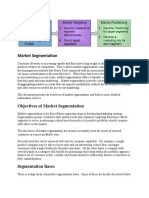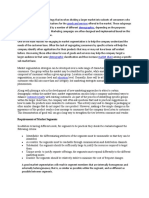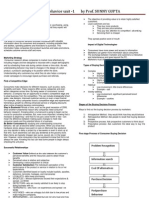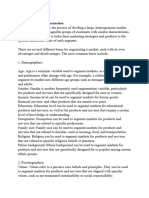0 ratings0% found this document useful (0 votes)
4 viewsChapter 2 CB
Chapter 2 CB
Uploaded by
Usman DastiCopyright:
© All Rights Reserved
Available Formats
Download as PDF, TXT or read online from Scribd
Chapter 2 CB
Chapter 2 CB
Uploaded by
Usman Dasti0 ratings0% found this document useful (0 votes)
4 views33 pagesOriginal Title
Chapter 2 CB (1)
Copyright
© © All Rights Reserved
Available Formats
PDF, TXT or read online from Scribd
Share this document
Did you find this document useful?
Is this content inappropriate?
Copyright:
© All Rights Reserved
Available Formats
Download as PDF, TXT or read online from Scribd
Download as pdf or txt
0 ratings0% found this document useful (0 votes)
4 views33 pagesChapter 2 CB
Chapter 2 CB
Uploaded by
Usman DastiCopyright:
© All Rights Reserved
Available Formats
Download as PDF, TXT or read online from Scribd
Download as pdf or txt
You are on page 1of 33
Javeria Hassan Khan
Market segmentation is the process of dividing a market
into subsets of consumers with common needs or characteristics.
Each subset represents a consumer group with shared needs that
are different from those shared by other groups.
Targeting consists of selecting the segments that the company
views as prospective customers and pursuing them.
Positioning is the process by which a company creates a distinct
image and identity for its products, services, and brands in
consumers’ minds. The image differentiates the company’s
offering from competition by communicating to the target
audience that the product, service, or brand fulfills their needs
better than alternatives.
Segmentation, targeting, and positioning
are interrelated and implemented
sequentially.
For example, airlines traditionally offered
three in-flight service choices: first class,
business class, and economy (or coach).
All consumers are not alike because they
have different needs, wants, and desires, and
different back-grounds, education levels, and
experiences.
Therefore, marketers must offer alternatives
that correspond to the needs of different
consumer groups or segments.
Market segmentation, strategic targeting,
and product (or service) positioning are the
key elements of marketing consumer goods
and services.
They enable producers to avoid head-on
competition in the marketplace by
differentiating their products on the basis of
such features as price, styling, packaging,
promotional appeal, method of distribution,
and level of service.
Effectively catering to the distinct needs of
consumers by offering them clearly
differentiated products is significantly more
profitable than mass marketing, in spite of
the much higher research, production,
advertising, and distribution costs that
accompany segmentation and strategic
targeting
Marketers divide consumers into separate
segments on the basis of common or shared
needs by using demographics, lifestyles, and
other factors named “bases for segmentation.”
Some segmentation factors, such as
demographics (e.g., age, gender, ethnicity), are
easy to identify, and others can be deter-mined
through questioning (e.g., education, income,
occupation, marital status).
Other features, such as the product benefits
buyers seek and customers’ lifestyles, are
difficult to identify and measure.
To be a viable market, a segment must
consist of enough consumers to make
targeting it profitable.
A segment can be identifiable, but not large
enough to be profitable.
Most marketers prefer to target consumer
segments that are relatively stable in terms of
lifestyles and consumption patterns (and are
also likely to grow larger and more viable in
the future) and avoid “fickle” segments that
are unpredictable.
To be targeted, a segment must be
accessible, which means that marketers must
be able to communicate with its consumers
effectively and economically.
Not every company is interested in or has the
means to reach every market segment, even
if that segment meets the four preceding
criteria.
Behavioral data is evidence-based; it can be
determined from direct questioning (or
observation), categorized using objective and
measurable criteria, such as demographics, and
consists of:
1. Consumer-intrinsic factors, such as a person’s
age, gender, marital status, income, and
education.
2. Consumption-based factors, such as the
quantity of product purchased, frequency of
leisure activities, or frequency of buying a given
product.
Cognitive factors are abstracts that “reside” in
the consumer’s mind, can be determined only
through psychological and attitudinal
questioning, and generally have no single,
universal definitions, and consist of:
1. Consumer-intrinsic factors, such as
personality traits, cultural values, and attitudes
towards politics and social issues.
2. Consumption-specific attitudes and
preferences, such as the benefits sought in
products and attitudes regarding shopping.
Demographic segmentation divides consumers
according to age, gender, ethnicity, income
and wealth, occupation, marital status,
household type and size, and geographical
location.
These variables are objective, empirical, and can
be determined easily through questioning or
observation.
They enable marketers to classify each
consumer into a clearly defined category, such
as an age group or income bracket.
All segmentation plans include demographic
data for the following reasons:
1. Demographics are the easiest and most logical
way to classify people and can be measured
more precisely than the other segmentation
bases.
2. Demographics offer the most cost-effective
way to locate and reach specific segments,
because most of the secondary data compiled
about any population consists of demographics
(e.g., U.S. Census Bureau, audience profiles of
various media)
3. Using demographics, marketers can identify
new segments created by shifts in
populations’ age, income, and location.
4. Demographics determine many
consumption behaviors, attitudes, and media
exposure patterns.
Benefit segmentation is based on the benefits
that consumers seek from products and services.
The benefits that consumers look for represent
unfilled needs, whereas buyers’ perceptions that
a given brand delivers a unique and prominent
benefit result in loyalty to that brand.
Marketers of personal care products, such as
shampoos, soaps, and toothpastes, create
different offerings designed to deliver specific
benefits.
As more and more forms of media emerge, marketers must
study the benefits that consumers seek from adopting these
communication tools, so that they can advertise in these
media effectively.
In one study, consumers singled out immediacy, accessibility,
and free cost as the most relevant features of digital
newspapers, while identifying writing style and more depth
and details as the key features of traditional newspapers.
These findings indicate that publishers of traditional
newspapers should position online and paper newspapers as
complementing one another and that the two versions
represent opportunities for somewhat different types of ads.
Usage rate segmentation reflects the differences
among heavy, medium, and light users, and nonusers
of a specific product, service, or brand.
Targeting heavy users is a common marketing
strategy and is often more profitable than targeting
other user categories.
However, catering to this segment requires a lot of
expensive advertising because all competitors target
the same heavy users.
Some marketers prefer to target light and medium
users with products that are distinct from those
preferred by heavy users.
Usage rate segmentation also focuses on the
factors that directly affect the usage
behavior.
The researchers also examined usage
frequency in relation to buyers’ reasons for
purchasing at that chain, levels of
expenditure at the store, travel times to the
store and modes of transportation, and
whether buyers came in from home, a job, or
were simply passing by.
Rate of usage is strongly related to product
awareness status, which is the degree of a
consumer’s awareness of the product and its
features, and whether or not he or she
intends to buy it reasonably soon.
A related factor is product involvement,
which reflects the degree of personal
relevance that the product holds for the
consumer.
Usage occasion segmentation recognizes that
consumers purchase some products for specific
occasions, as expressed in the following
statements:
• “Whenever our son celebrates a birthday, we
take him out to dinner at the Gramercy Tavern”
• “When I’m away on business for a week or
more, I try to stay at the Setai”
• “I always buy my wife candy on Valentine’s
Day”
Behavioral targeting consists of sending
consumers personalized and prompt offers and
promotional messages designed to reach the
right consumers and deliver to them highly
relevant messages at the right time and more
accurately than when using conventional
segmentation techniques.
This method is enabled by tracking online
navigation, current geographic location, and
purchase behavior.
Tracking consumers’ navigation online includes:
1. Recording the websites that consumers visit.
2. Measuring consumers’ levels of engagement
with the sites (i.e., which pages they look at, the
length of their visits, and how often they return).
3. Recording the visitors’ lifestyles and
personalities (derived from the contents of
consumers’ blogs, tweets, and Facebook profiles).
4. Keeping track of consumer’ purchases, almost
purchases (i.e., abandoned shopping carts), and
returns or exchanges.
Smart phones and GPS devices have created
highly effective targeting opportunities.
Customers’ mobile devices brought upon
problems for brick-and-mortar retailers.
Customers frequently engage in showrooming,
which occurs when consumers use smart phones
to scan the bar codes of products displayed in
physical stores and then check the items’ prices
online in order to purchase them at the lowest
prices.
In order to combat showrooming, some
physical stores started geofencing, which
consists of sending promotional alerts to the
smartphones of customers who opted into
this service, when the customers are near or
enter the store.
You might also like
- November 07, 2016 PDFDocument8 pagesNovember 07, 2016 PDFChristine HogueNo ratings yet
- Whitepaper: Welcome To VINCIDocument34 pagesWhitepaper: Welcome To VINCIandy sanjayaNo ratings yet
- SCM Chapter NotesDocument50 pagesSCM Chapter Notesnishavijay0586% (37)
- IT448 - Mobile AppDocument31 pagesIT448 - Mobile AppKhulood AlhamedNo ratings yet
- Lecture 2Document2 pagesLecture 2Zuhair RiazNo ratings yet
- Wants: Jobs To Be Done and Outcome-Driven Customer ResearchDocument3 pagesWants: Jobs To Be Done and Outcome-Driven Customer ResearchRaj SatyakiNo ratings yet
- Marketing ResearchDocument11 pagesMarketing ResearchgoudarameshvNo ratings yet
- Bajaj TheoryDocument5 pagesBajaj TheoryNikhil IngaleNo ratings yet
- Strategic Marketing AssignmentDocument12 pagesStrategic Marketing AssignmentDaniel Chege100% (1)
- Consumer Behaviour & Market Research - Week 1Document19 pagesConsumer Behaviour & Market Research - Week 1NailaNo ratings yet
- Market SegmentationDocument18 pagesMarket SegmentationpawanNo ratings yet
- TH106 Information Sheet 3.1-1Document5 pagesTH106 Information Sheet 3.1-1Djared James MinasNo ratings yet
- Kanenus CollegeDocument6 pagesKanenus CollegeGetu AlemuNo ratings yet
- Marketing ProjectDocument38 pagesMarketing ProjectVidya GNo ratings yet
- ParaphraseDocument14 pagesParaphraseHannah ArohaNo ratings yet
- Chapter 4 SegementationDocument7 pagesChapter 4 SegementationJk KNo ratings yet
- Consumer BehaviourDocument7 pagesConsumer BehaviourLiv DNo ratings yet
- Chapter - 3 Market SegmentationDocument18 pagesChapter - 3 Market SegmentationCindy Graze EscaleraNo ratings yet
- Topic 2-Marketing SegmentationDocument23 pagesTopic 2-Marketing SegmentationTanvir Ahmed RajibNo ratings yet
- Goods and Services Demographics: Requirements of Market SegmentsDocument4 pagesGoods and Services Demographics: Requirements of Market SegmentsmdayvieNo ratings yet
- Im Unit 3Document10 pagesIm Unit 3Ankush TyagiNo ratings yet
- Rittik Shee Report (Consumer Behavior)Document11 pagesRittik Shee Report (Consumer Behavior)R SheeNo ratings yet
- IARE - CB - Lecture - Notes-11-20Document10 pagesIARE - CB - Lecture - Notes-11-20Santhosh Kumar MaduraiNo ratings yet
- Unit 2 NotesDocument19 pagesUnit 2 NotesMayuri ShettiNo ratings yet
- Market Segmentation: Uses and Bases of SegmentationDocument21 pagesMarket Segmentation: Uses and Bases of SegmentationaksamyalNo ratings yet
- TempDocument9 pagesTempMardyNo ratings yet
- Profile The Market NewDocument10 pagesProfile The Market Newdenekedarchu358No ratings yet
- CB Unit1Document5 pagesCB Unit1Sonalee ChauhanNo ratings yet
- Consumer MarketsDocument2 pagesConsumer Marketsgeovana torreroNo ratings yet
- Week 6: Market Segments and TargetsDocument4 pagesWeek 6: Market Segments and TargetsNmNo ratings yet
- Lesson 5 Marketing Segmentation and TargetingDocument11 pagesLesson 5 Marketing Segmentation and Targetingsamson anyumbaNo ratings yet
- Daily BazarDocument3 pagesDaily BazarKRISHNAPRIYA BABYNo ratings yet
- Jomo Kenyatta University of Agriculture and Technology: NameDocument9 pagesJomo Kenyatta University of Agriculture and Technology: NameRedemptah Mutheu MutuaNo ratings yet
- Segmentation Targeting Positioning (STP)Document20 pagesSegmentation Targeting Positioning (STP)doreen11No ratings yet
- Importance of Measuring The Effectiveness of AdvertisingDocument11 pagesImportance of Measuring The Effectiveness of AdvertisingAmit KumarNo ratings yet
- Service Marketing Assignment 1Document3 pagesService Marketing Assignment 1robessfightNo ratings yet
- MARKETINGDocument49 pagesMARKETINGpropraveen1603No ratings yet
- Market Profiling - SegmentationDocument3 pagesMarket Profiling - SegmentationCL AhNo ratings yet
- Factors Affecting Consumer BehaviorDocument9 pagesFactors Affecting Consumer Behaviorraam06No ratings yet
- Chapter-3: Women Consumers in IndiaDocument31 pagesChapter-3: Women Consumers in IndiaSatish ChaudharyNo ratings yet
- Bases of Market SegmentationDocument27 pagesBases of Market Segmentationmeghamarik123No ratings yet
- MG T 410 Sessional 1Document7 pagesMG T 410 Sessional 1Muhammad Usman AshrafNo ratings yet
- Market Segementation - 2Document22 pagesMarket Segementation - 2Janhvi JaiswalNo ratings yet
- Chapter 1 - Introduction To Consumer BehaviorDocument25 pagesChapter 1 - Introduction To Consumer BehaviorYUSRA ANSARNo ratings yet
- UNIT I: The Pharmaceutical Health Care Industry: Customer WANTS and NEEDSDocument12 pagesUNIT I: The Pharmaceutical Health Care Industry: Customer WANTS and NEEDSrb YangzonNo ratings yet
- MERCADEODocument3 pagesMERCADEOAlexNo ratings yet
- 1.2 - Market SegmentationDocument3 pages1.2 - Market SegmentationPeterNo ratings yet
- Bsba-Om The Nature of Consumer BehaviorDocument7 pagesBsba-Om The Nature of Consumer BehaviorMigs DomingoNo ratings yet
- Unit II MMDocument8 pagesUnit II MMJatinsinghNo ratings yet
- Schiffman cb11 Im01Document19 pagesSchiffman cb11 Im01Perihan SalahNo ratings yet
- Consumer BehaviourDocument42 pagesConsumer Behaviourtamilarasu.r11No ratings yet
- Unit 2Document21 pagesUnit 2Himanshu DarganNo ratings yet
- DM Individual ActivityDocument10 pagesDM Individual ActivityAnoop AnilNo ratings yet
- Unit 3Document28 pagesUnit 3PRABHAKAR RAONo ratings yet
- Marketing Basics of Start-Up BusinessDocument18 pagesMarketing Basics of Start-Up BusinessAv PedranoNo ratings yet
- Bachelor in Business Administration Semester 3: Prepared For: Lecturer's NameDocument11 pagesBachelor in Business Administration Semester 3: Prepared For: Lecturer's NameBrute1989No ratings yet
- Marketing Mangement AssignmentDocument13 pagesMarketing Mangement AssignmentManinder KaurNo ratings yet
- The Need For Market SegmentationDocument4 pagesThe Need For Market Segmentationsrikanthk_98No ratings yet
- Marketing Management - CHAPTER 6Document17 pagesMarketing Management - CHAPTER 6Ewan DikoNo ratings yet
- Cunsumer Behavior Unit 1 Chapter 1&2Document8 pagesCunsumer Behavior Unit 1 Chapter 1&2patricka taylorNo ratings yet
- Market SegmentationDocument30 pagesMarket Segmentationmldc2011No ratings yet
- DissertatioC BDocument16 pagesDissertatioC BKumar SwamyNo ratings yet
- Development of The Marketing Concept and The Discipline of Consumer BehaviourDocument8 pagesDevelopment of The Marketing Concept and The Discipline of Consumer BehaviourSouvik PurkayasthaNo ratings yet
- Lecture 5 & 6-Week 3-Origins of Western SocietyDocument42 pagesLecture 5 & 6-Week 3-Origins of Western SocietyUsman DastiNo ratings yet
- Thrift InstitutionsDocument12 pagesThrift InstitutionsUsman DastiNo ratings yet
- Lecture # 16 Part 2 Index Analysis FMDocument107 pagesLecture # 16 Part 2 Index Analysis FMUsman DastiNo ratings yet
- Types of Financial MarketsDocument6 pagesTypes of Financial MarketsUsman DastiNo ratings yet
- Lecture # 4 FMDocument19 pagesLecture # 4 FMUsman DastiNo ratings yet
- Pom 6Document36 pagesPom 6Usman DastiNo ratings yet
- Lecture # 6 FMDocument26 pagesLecture # 6 FMUsman DastiNo ratings yet
- Lecture # 13 FMDocument11 pagesLecture # 13 FMUsman DastiNo ratings yet
- Chapter 1 Imperatives For Market Driven StrategiesDocument45 pagesChapter 1 Imperatives For Market Driven StrategiesUsman DastiNo ratings yet
- Lecture 21 Finance TheoriesDocument10 pagesLecture 21 Finance TheoriesUsman DastiNo ratings yet
- Pom 5Document27 pagesPom 5Usman DastiNo ratings yet
- Lecture 27 Theory 3 Signaling TheoryDocument4 pagesLecture 27 Theory 3 Signaling TheoryUsman DastiNo ratings yet
- POM-7 Loc - StrategyDocument21 pagesPOM-7 Loc - StrategyUsman DastiNo ratings yet
- Lecture 7 & 8-Week 4-Society, Culture and ChangeDocument26 pagesLecture 7 & 8-Week 4-Society, Culture and ChangeUsman DastiNo ratings yet
- The Globalization Debate (Political, Cultural, Ideological & Social Aspects of Globalization)Document11 pagesThe Globalization Debate (Political, Cultural, Ideological & Social Aspects of Globalization)Usman DastiNo ratings yet
- Non Traditional Security - Water Crisis, Energy Crisis and Environmental IssuesDocument17 pagesNon Traditional Security - Water Crisis, Energy Crisis and Environmental IssuesUsman DastiNo ratings yet
- Lec 15-Conflict Management & Organizational BehaviorDocument18 pagesLec 15-Conflict Management & Organizational BehaviorUsman DastiNo ratings yet
- The Clash of Civilizations - The West Vs Islam, The Issue of FundamentalismDocument11 pagesThe Clash of Civilizations - The West Vs Islam, The Issue of FundamentalismUsman DastiNo ratings yet
- Lec 12 - Interviewing and AssessmentDocument14 pagesLec 12 - Interviewing and AssessmentUsman DastiNo ratings yet
- Pale Cases Canon 1-6Document75 pagesPale Cases Canon 1-6KylaNo ratings yet
- Locker ModuleDocument32 pagesLocker ModulebinalamitNo ratings yet
- Igrafx Cloud DataSheetDocument2 pagesIgrafx Cloud DataSheetCharles A WilsonNo ratings yet
- LAC SESSION TEMPLATE DISTRICT MUNICIPAL SCHOOL LEVEL Revised 8 17 2017Document3 pagesLAC SESSION TEMPLATE DISTRICT MUNICIPAL SCHOOL LEVEL Revised 8 17 2017Jakie UbinaNo ratings yet
- P6NK90ZDocument13 pagesP6NK90ZVictor ChangNo ratings yet
- Literature ReviewDocument4 pagesLiterature Reviewapi-549248807No ratings yet
- Midterm Exam.: College of Architecture & Environmental PlanningDocument9 pagesMidterm Exam.: College of Architecture & Environmental PlanningHaruNo ratings yet
- CI - Capacity Building For Maintenance of Meteorological Instruments and Early Warning SystemDocument20 pagesCI - Capacity Building For Maintenance of Meteorological Instruments and Early Warning SystemHairatun NisaNo ratings yet
- Fast Track CFP Exam 5 (Final Exam) Preparation Training Workshop1Document2 pagesFast Track CFP Exam 5 (Final Exam) Preparation Training Workshop1keyur1975No ratings yet
- S4Hana - SD Integration With FICODocument74 pagesS4Hana - SD Integration With FICOBhargav ReddyNo ratings yet
- Automatic Bottle Filling and Capping Machine Using SCADA With The Internet of ThingsDocument6 pagesAutomatic Bottle Filling and Capping Machine Using SCADA With The Internet of Thingsa.louiziniNo ratings yet
- Ayaz Nujuraully - 59376351 1Document12 pagesAyaz Nujuraully - 59376351 1AzharNo ratings yet
- Alarm Device ListDocument5 pagesAlarm Device Listluiz carlos bonafini jrNo ratings yet
- AWS Certified Machine Learning: Specialty - Exam Overview and PreparationDocument14 pagesAWS Certified Machine Learning: Specialty - Exam Overview and PreparationArturo OsorioNo ratings yet
- Don - Nan Pump & SupplyDocument180 pagesDon - Nan Pump & Supplyjuliocanel2009100% (1)
- Assignment # (02) : Abasyn University Peshawar Department of Computer ScienceDocument4 pagesAssignment # (02) : Abasyn University Peshawar Department of Computer ScienceAndroid 360No ratings yet
- Collections in JavaDocument24 pagesCollections in JavaKISHOREMUTCHARLA100% (1)
- Digital Circuits: EE/CE 3320 / Spring 2020 / Lecture 12Document82 pagesDigital Circuits: EE/CE 3320 / Spring 2020 / Lecture 12Muhammad MontahaNo ratings yet
- Music Industry Project Assignment BriefDocument7 pagesMusic Industry Project Assignment Briefapi-256223222No ratings yet
- Strategic Management in Business CheatsheetDocument2 pagesStrategic Management in Business CheatsheetBobo WongNo ratings yet
- G7 Math Q3 - Week 8 - Classification of PolygonsDocument24 pagesG7 Math Q3 - Week 8 - Classification of PolygonsROSEMARIE SANTOSNo ratings yet
- The French RevolutionDocument2 pagesThe French RevolutionRupjyotiNo ratings yet
- ManfDocument34 pagesManfAnantha NarayananNo ratings yet
- Perry Como Papa Loves MamboDocument10 pagesPerry Como Papa Loves MamboAnonymous gPhRqg30% (1)
- Basics Using Matlab Fuzzy ToolboxDocument65 pagesBasics Using Matlab Fuzzy Toolboxdieu_ag2No ratings yet
- Personal Knowledge Management: by Bruno WinckDocument4 pagesPersonal Knowledge Management: by Bruno WinckDuke NguyenNo ratings yet












































































































